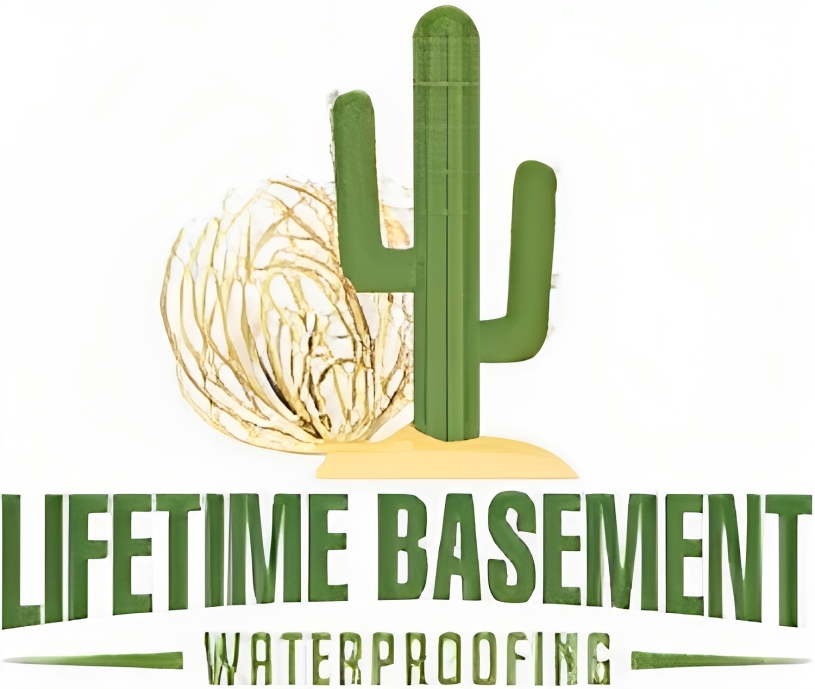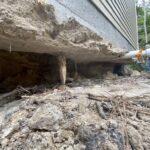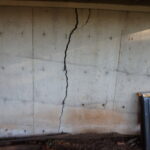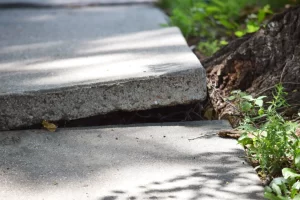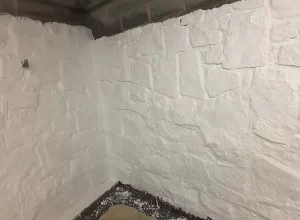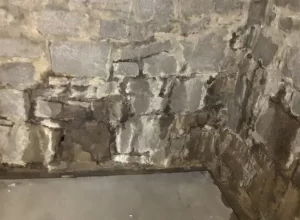
Inspecting foundation cracks is essential for maintaining your home’s structural integrity. Grab a flashlight to spot damages, use a tape measure to assess crack dimensions, and check alignment with a level. Look for visible cracks, water damage, and soil erosion indoors and outdoors, and be wary of different crack types like horizontal or stair-step. DIY repair techniques like polyurethane sealant can help, but if in doubt, seek professional assistance to prevent extensive damage. Regularly monitor your foundation and follow preventative maintenance tips to keep your home safe and sound. Discover more helpful tips to safeguard your home.
Key Takeaways
- Regularly inspect for cracks, moisture, and uneven floors.
- Utilize flashlight, tape measure, and level for accurate evaluation.
- Look for different crack types: vertical, horizontal, stair-step, diagonal.
- Use polyurethane sealant or patch and seal for repairs.
- Seek professional help for critical displacement or widespread issues.
Importance of Foundation Inspections
Regular foundation inspections are vital for maintaining the structural integrity of your home. By conducting routine inspections, you can catch any potential issues early on and prevent them from turning into costly repairs down the line. Your home’s foundation plays an important role in supporting the entire structure, so keeping it in good condition is paramount for your safety and the longevity of your property.
During these inspections, you should look out for signs of foundation damage such as cracks, uneven floors, gaps around windows or doors, and moisture issues. These issues can indicate underlying problems that need to be addressed promptly. Ignoring these warning signs could lead to more severe damage over time, jeopardizing the stability of your home.
In addition to maintaining the structural integrity of your home, regular foundation inspections can also help you identify any potential safety hazards. A compromised foundation can pose risks to you and your family, especially during natural disasters like earthquakes or floods. By staying proactive and addressing any foundation issues early on, you can guarantee that your home remains a safe and secure place for everyone.
Tools Needed for Inspection
To perform a thorough foundation inspection, you’ll need essential tools such as a flashlight, a tape measure, and a level. These tools are vital for accurately evaluating the condition of your foundation and identifying any potential issues. Here are the tools you’ll need:
- Flashlight: A dependable flashlight is necessary for illuminating dark areas under the house or in the basement. It will help you pinpoint cracks, water leaks, or any other signs of damage that may not be easily visible in dimly lit spaces.
- Tape Measure: Measuring the dimensions of cracks or gaps in the foundation is crucial for determining their severity. A tape measure will allow you to precisely record the size of any issues you encounter during your inspection.
- Level: A level is essential for checking the alignment and slope of the foundation walls and floors. It will help you identify any areas where the foundation may have shifted or settled unevenly, indicating potential structural problems.
Having these tools on hand will enable you to conduct a thorough inspection of your foundation, empowering you to catch any issues early and prevent further damage to your home.
Exterior Inspection Techniques
Inspecting the exterior of your home’s foundation can provide valuable insights into its overall condition and potential structural issues. Begin by walking around your home and carefully examining the foundation for any visible cracks or gaps. Look for vertical cracks, which may indicate settlement issues, or horizontal cracks, which could be a sign of water pressure against the foundation. Pay close attention to the corners of your home, as they’re common areas for cracks to develop.
Next, check the exterior walls for any signs of water damage or discoloration. Stains or mold growth could suggest water is seeping into the foundation, which can weaken its structure over time. Additionally, inspect the gutters and downspouts to make sure they’re directing water away from the foundation. Clogged or damaged gutters can lead to water pooling around the foundation, causing potential damage.
Take note of any areas where the soil is eroding or pulling away from the foundation. Proper grading is vital to prevent water from pooling near the foundation. If you notice any issues with the soil, consider regrading the area to guarantee proper drainage. By regularly inspecting the exterior of your home’s foundation, you can catch potential problems early and prevent costly repairs down the line.
Interior Inspection Techniques
When conducting an inspection of your home’s foundation, start by examining the interior walls for any visible cracks or signs of water damage. This step is vital in identifying potential issues that may be affecting the stability of your home.
Here are some interior inspection techniques to help you assess your foundation:
- Use a flashlight: Shine a bright light along the walls, especially in areas where natural light may not reach easily. This will help you spot even the smallest cracks that could indicate foundation problems.
- Check for moisture: Look for any signs of water damage, such as damp spots, mold, or mildew. These can be indications of water seepage through cracks in the foundation.
- Inspect corners and edges: Pay close attention to the corners of your walls and where walls meet ceilings or floors. These are common areas where cracks may develop due to foundation settling or movement.
Different Types of Cracks to Look For
Start by identifying the different types of cracks that may appear in your home’s foundation to effectively assess any potential issues affecting its stability. There are several common types of cracks that homeowners should be aware of.
- Vertical Cracks: These cracks typically run straight up and down and are often caused by normal settling of the house. They’re usually not a major concern unless they’re wider than 3mm.
- Horizontal Cracks: Horizontal cracks are more serious and could indicate a more severe issue such as pressure from the soil outside pushing against the foundation. These cracks should be evaluated by a professional.
- Stair-Step Cracks: These cracks zigzag along the mortar joints in brick walls and are commonly seen in older homes. They can be a sign of foundation settlement or heaving and should be inspected by an expert.
- Diagonal Cracks: Diagonal cracks that are wider at the top than at the bottom could be a sign of differential settlement, which may require immediate attention.
- Cracks in the Basement Floor: While hairline cracks in the basement floor are common and not usually a cause for concern, larger cracks or ones that are growing could indicate underlying issues with the foundation.
Signs of Structural Damage
To assess structural damage, carefully observe for any visible signs of cracks, shifts, or distortions in the foundation of your home. These indicators can help you determine the extent of the damage and whether professional intervention is necessary.
Here are three key signs of structural damage to look out for:
- Cracks: Look for cracks in the foundation walls, especially ones that are wider than a quarter of an inch. Horizontal cracks, stair-step cracks in masonry joints, or vertical cracks that are wider at the top can indicate serious structural issues.
- Doors and Windows: Pay attention to any doors or windows that are sticking, jammed, or no longer closing properly. Misaligned doors and windows could be a sign of foundation movement, causing the frames to shift out of place.
- Uneven Floors: Walk around your home and check for any areas where the floor feels uneven or slopes. Sloping floors, especially if they’re accompanied by cracking or shifting in the walls, can suggest significant structural problems that need to be addressed promptly.
DIY Repair Options
Consider exploring simple DIY repair options for minor foundation cracks before seeking professional assistance to address any potential structural issues in your home. Taking care of small cracks early on can help prevent them from developing into more significant problems down the line. Here are some DIY repair options you can try:
- Epoxy Injections: Use epoxy injections to fill in hairline cracks in your foundation. This method can help strengthen the crack and prevent water from seeping in.
- Hydraulic Cement: Hydraulic cement is a quick-setting option that can be used to fill in cracks. It expands as it dries, ensuring a tight seal.
- Polyurethane Sealant: Polyurethane sealant is flexible and can be used for cracks that may still be shifting slightly. It’s a good option for sealing cracks in basements.
- Patch and Seal: Clean out the crack, apply a concrete patching compound, and then seal the area with a waterproof sealant for a simple yet effective fix.
- Monitor for Changes: After repairing the crack, monitor it regularly to make sure the fix holds. If you notice any further movement or widening, it may be time to call in a professional.
When to Seek Professional Help
If you notice foundation cracks that are significant, deep, or rapidly expanding, it’s advisable to seek professional help promptly. These signs could indicate serious structural issues that require expert assessment and repair.
Here’s when you should consider getting professional assistance:
- Critical displacement: If you observe that parts of your foundation have shifted or moved, such as walls pulling away from the house or doors and windows becoming misaligned, it’s essential to have a professional inspect the foundation. These visible displacements can be a warning sign for significant underlying problems.
- Numerous cracks: When you see multiple cracks in different areas of your foundation, especially if they’re accompanied by other symptoms like sticking doors or sloping floors, it’s best to consult with a professional. Multiple cracks suggest widespread or systemic issues that need professional attention.
- Water leakage: If you notice water seeping through foundation cracks, it’s a sign of potential water damage and drainage issues. Moisture infiltration can weaken the foundation over time, leading to more severe problems. A professional can assess the extent of the water damage and recommend appropriate solutions to prevent further deterioration.
Preventative Maintenance Tips
Inspect your foundation regularly for any signs of damage and implement preventative maintenance tips to avoid costly repairs in the future.
Here are some simple yet effective preventative measures you can take to keep your foundation in good shape:
- Maintain Proper Drainage: Guarantee that the soil around your foundation slopes away from your home to prevent water from pooling around the foundation walls. Clean out your gutters regularly to avoid clogs and ensure proper water flow.
- Monitor Tree Roots: Trees planted too close to your home can cause foundation damage as their roots grow. Keep trees trimmed and plant them a safe distance away from your foundation.
- Address Plumbing Leaks: Check for any plumbing leaks around your home and repair them promptly. Water from leaks can seep into the foundation and weaken it over time.
- Control Moisture Levels: Use a dehumidifier in damp basements or crawl spaces to reduce moisture levels. Excess moisture can lead to foundation problems like cracks and mold growth.
- Inspect for Pest Infestations: Regularly check for signs of termites or other pests that can damage your foundation. Take necessary steps to eliminate the infestation promptly.
Monitoring and Follow-Up
To guarantee the ongoing health of your foundation, consistently monitor for any changes or issues that may arise. Regular checks can help catch potential problems early, saving you time and money in the long run. Here are three key aspects to focus on when monitoring your foundation:
- Visual Inspections: Take a walk around your home and inspect the foundation for any new cracks, shifts, or signs of water damage. Look for changes in the size or direction of existing cracks, as well as any gaps between the foundation and the surrounding structures.
- Use a Moisture Meter: Invest in a moisture meter to detect any unusual levels of moisture in your foundation. High moisture levels can indicate drainage issues or leaks, which may compromise the integrity of your foundation over time.
- Document Changes: Keep a detailed record of your foundation inspections, noting the date, location, and any observations you make. By documenting changes over time, you can track the progression of any issues and provide valuable information to professional inspectors if needed.
Frequently Asked Questions
Can Foundation Cracks Be Repaired Without Professional Help?
Yes, foundation cracks can often be repaired without professional help. Assess the crack size and type first. Small vertical cracks are manageable, but horizontal or wide cracks may indicate structural issues and require expert evaluation and repair.
Are There Any DIY Methods to Prevent Foundation Cracks From Forming?
To prevent foundation cracks, establish proper drainage, maintain consistent moisture levels around the foundation, and address any landscaping issues. Regularly inspect for signs of shifting or settling. By taking these steps, you can help safeguard your home’s foundation.
How Can I Determine if a Crack in My Foundation Is a Sign of Structural Damage?
To determine if a crack in your foundation signifies structural damage, monitor the crack’s width, length, and any changes. Look for horizontal cracks, widening gaps, or signs of movement. Consult a professional if concerned.
Are There Any Specific Types of Foundation Cracks That Are More Concerning Than Others?
When inspecting your foundation, look out for vertical cracks wider than 1/4 inch, horizontal cracks, or stair-step cracks in masonry joints. These types of cracks can indicate more serious structural issues that require professional evaluation.
How Often Should Homeowners Perform Foundation Crack Inspections?
You should perform foundation crack inspections at least once a year to catch issues early. Look for new cracks or changes in existing ones. Prompt attention can prevent costly repairs and protect your home’s structural integrity.
Conclusion
Lifetime Basement Waterproofing has been Atlanta’s premier basement waterproofing company for over 30 years. As a family-owned and operated business, we specialize in basement waterproofing and offer a range of expert services.
Our expertise extends to crawlspace encapsulation, exterior foundation waterproofing, foundation crack repair, and designing drainage solutions like French drains.
Trust Lifetime Basement Waterproofing for all your wet basement repair needs, ensuring the longevity and safety of your home.
